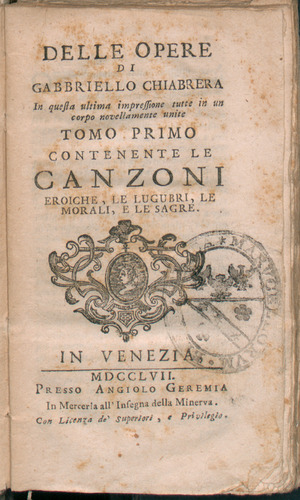Gabriello Chiabrera facts for kids
Quick facts for kids
Gabriello Chiabrera
|
|
|---|---|

Ottavio Leoni, Gabriello Chiabrera, 1625, engraving and stipple in laid paper, Washington, National Gallery of Art
|
|
| Born | 18 June 1552 Savona, Republic of Genoa |
| Died | 14 October 1638 (aged 86) Savona, Republic of Genoa |
| Occupation | Poet |
| Language | Italian |
| Nationality | Italian |
| Period | Late Middle Ages |
| Literary movement | Baroque |
| Notable works | Canzonette Il rapimento di Cefalo Orfeo dolente |
| Spouse | Lelia Pavese |
Gabriello Chiabrera (born June 18, 1552 – died October 14, 1638) was an Italian poet. Some people called him the "Italian Pindar" because of his style. He created new ways of writing poetry, using different rhythms and a style inspired by ancient Greece. This helped other Italian poets later on.
Contents
Life Story of Gabriello Chiabrera
Gabriello Chiabrera was born in Savona, a small town in the Republic of Genoa. This was about 28 years after a famous French poet, Pierre de Ronsard, was born. Chiabrera came from a noble family.
Early Life and Education
Gabriello was born after his father had passed away. When he was nine years old, he moved to Rome to live with his uncle, Giovanni. He had a private tutor who taught him.
He got sick twice with fevers. Because of this, he was sent to a Jesuit school. He stayed there until he was 20. He studied philosophy, which is about big ideas, but he said he did it more to keep busy than to become a scholar.
Returning Home and Discovering Poetry
When his uncle passed away, Chiabrera went back to Savona. He wanted to see his family and friends again. Later, he returned to Rome and worked for a cardinal.
During this time, he met other important writers like Paulus Manutius and Sperone Speroni. He also listened to lectures and discussions by a scholar named Muretus.
An incident happened that made him go back to Savona again. To pass the time, he started reading a lot of poetry, especially Greek poems.
Finding His Poetic Voice
Chiabrera especially loved the Greek poets Pindar and Anacreon. He studied their work carefully. He wanted to create similar rhythms and structures in Italian. His goal was to bring a new kind of poetry to his country. He felt like Christopher Columbus, wanting to discover a "new world" in poetry.
His new style quickly became famous. Even though he was often invited to visit royal courts, he usually stayed in Savona. He enjoyed traveling for fun, and sometimes he would visit princes who admired his poetry and plays.
Later Years and Legacy
When he was 50, Gabriello married Lelia Pavese, but they did not have children. He lived a simple and good life. He wrote many different kinds of poems, including long epic poems, plays, and songs.
Gabriello Chiabrera died in Savona on October 14, 1638. Even Pope Urban VIII wrote a nice Latin message for him. On his tombstone, there are two short Italian lines he wrote himself. They warn people not to value poetry (like Mount Parnassus) more than faith (like Calvary).
Gabriello Chiabrera's Works
Chiabrera was known for his odes, which are like long, formal poems. He used complex rhythms and new, fancy words. He also changed the usual order of words in his sentences. He created a new way of writing poetry.
People often compared him to the French poet Ronsard. Both poets became very famous quickly, but then their fame faded just as fast. After Ronsard, French literature changed. After Chiabrera, Italian literature didn't have many great writers until Alessandro Manzoni much later.
Even so, Chiabrera was a talented writer, not just someone who tried new things. While his long epic poems and plays might be less interesting today, many of his shorter songs, called Canzonette, are still beautiful and fun to read. His own story about his life is also very interesting.
He truly loved Greek poetry and would call anything he liked "Greek Verse." He enjoyed traveling and seeing new places. He didn't like talking about literature unless it was with close friends. He was proud of the favors he received from popes and princes. He was amazed by the poetry of Virgil. He also had a quiet Christian faith. All these things show us more about the poet who believed he had discovered a "new world" of art.
See also
 In Spanish: Gabriello Chiabrera para niños
In Spanish: Gabriello Chiabrera para niños


